Daykokuya Koda
Everywhere the same trouble
The wind still cools.
(A friend who went to the West)
Matsuo Basho (1644 - 1694). Translated by V. Markova.
Those who read James Clavell's “The Shogun” or saw his film adaptation undoubtedly noticed that the main idea of this film is the clash of two cultures - the rough Protestant culture of England from the end of the 16th century and the Japanese, Shinto and Buddhist, which absorbed many Chinese traditions and Undoubtedly, much more ancient and refined. Far from immediately, the English sailor pilot Blacksorn begins to realize that barbarians are not Japanese, but that he himself is a barbarian and ... changes his views in many ways. But did it happen in stories so that a European does not fall into Japan, and the Japanese in Europe? Yes, in the past it happened, and this, moreover, this Japanese, a courageous traveler in the era of the Tokugawa shoguns, became a completely non-native Japanese!
Japanese coastal vessel. From the series "Thirty-six views of Fuji"
Artist: Katsushika Hokusai, 1760-1849 Tokyo (Edo). Metropolitan Museum, New York.
It was the case that in 1783, the Japanese vessel “Sinse-maru” plunged into a strong storm, and then seven months (you can only imagine - seven, seven months at sea!) Rushed through the Pacific Ocean, and then threw it onto the island Amchitka - land owned by Russia.
The captain of the ship, Daikokuya Kodau, and several other members of his crew escaped. Fortunately, they met Russian industrialists who were waiting for a ship that came every three years. There were no other options, and the Japanese remained on the island together with the Russians and began to learn Russian. It is beautiful, your language, they said, is very capacious, but it is painfully difficult to learn it, since "in the Russian alphabet, the letters, although they have sound, do not make sense." And it turned out that Russian sounds: consonants - в, ж, л, ф, ч, ц, ш, щ; and vowels - e, s, the Japanese have no language and need to learn to pronounce them, which was very difficult for adults!
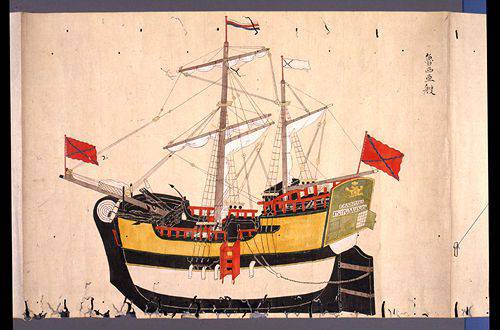
Brigantine "Catherine", which brought Daikokuya Kodaju back to Japan. Tokyo National Museum.
Three years passed, the long-awaited ship arrived, and ... crashed right at the entrance to the ship. The crew of the Shinsho Maru had already experienced the death of his ship, and the new disaster was a blow to him. The prospect of spending another few years here on the island in anticipation of another Russian ship would have been too difficult for everyone. But from the wreckage of the ship for two years with their own hands and almost without tools they managed to build a new ship and on it reached Kamchatka! But they could solve the problem with the Japanese only in Petersburg, therefore their “senior” should go there!
In 1789, the Japanese who survived (some sailors died of scurvy on the island) arrived in Irkutsk, and, meeting there with their fellow countrymen, decided to convert to Orthodoxy and not return. Sailor Sedzo, for example, at baptism became Fedor Stepanovich Sitnikov, and Shinzo - Nikolai Petrovich Kolotygin. And they did it not at all because of their love for Russia, but because of the harsh, and even very harsh, necessity. Indeed, in Japan of that time there was a law according to which ordinary Japanese could not swim away from the coast for a distance of more than three days in transit, so that for a longer period they would not be able to meet Europeans there and - God forbid, to adopt from them that Something bad. Violators of the law on the return of the death penalty!
In Irkutsk, Kodayu met Kirill Gustavovich Laxman, a member of the Petersburg Academy of Sciences, who wrote to the capital a petition for permission for Japanese sailors to return to their homeland. The answer, however, never came, and then Laxman made Koda an interesting offer: go there yourself and get official permission from the authorities, without which the local authorities would not dare to lift a finger. And then 15 January 1791, they left Irkutsk and headed for the capital.
Kodaev’s journey across the Russian empire — a merchant's man of rank, but educated and well-read, allowed him to study Russia well and record everything he saw. He was delighted with the expanses of the Russian lands, which were close to Japan, where every piece of flat land was valued, he seemed completely immense. He turned out to be an attentive observer and noticed that our soil is less fertile, that our agriculture is laborious and the harvests are scarce, but the fact that the Russians used little rice saw evidence of their poverty.
Russians saw them as Kodau described them as tall, white-skinned, blue-eyed, with large noses and brown hair. He considered them people to be respectful, inclined to peacefulness, but at the same time courageous and resolute, to idleness and idleness not accustomed. It turns out that his description is very different from what Western European travelers wrote about Russia and its people, and they visited us before it and later.
In June 1791, Captain Kodaju arrived in the capital and was solemnly invited to Tsarskoye Selo. The official reception was very dignified and made a strong impression on the Japanese. However, he also struck a lot of Russian courtiers, as he appeared at the court in his national costume and with a samurai sword in a belt. Empress Catherine the Great took his story to heart and promised assistance. And when she gave him his hand, he licked her three times, than he offered her the deepest, in his opinion, reverence. After all, a kiss to the Japanese was then unknown - their mentality and the mentality of the Europeans were so deeply different.
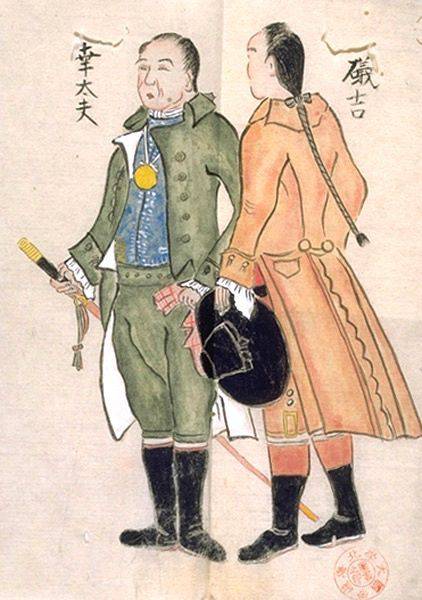
The crew members of the Shinsho-maru Daykokuya Kodaju (left) and Isokiti after returning to Japan in 1792 year. Tokyo National Museum.
Fortunately, Kodaju got used to difficult Japanese rituals at home, so he even considered that in Russia imperial persons keep themselves very simple. And when the heir to the throne, Tsesarevich Pavel Petrovich sat him in his carriage, and even without swagger, he sat next to him, it became a real shock for him, because for the Japanese to sit like that with the emperor’s son was equivalent to sacrilege.
Being in the capital of Russia, Koda willingly spoke with stories about his homeland in universities, and schools, and at secular receptions and even ... in brothels. Apparently he understood that he was laying the foundations for good neighborliness and understanding between our peoples and he tried very hard to maintain the dignity of his country. Therefore, although he was not a samurai, he behaved like a real samurai and came to all secular receptions in embroidered silk kimonos and hakama bloomers, as well as with a short wakizashi sword, causing universal amazement.
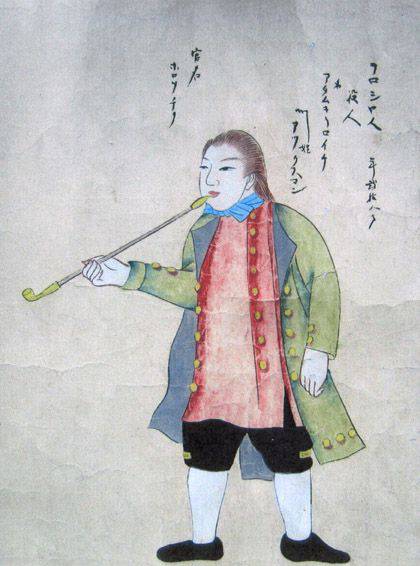
Adam Laxman - son of Cyril Laxman - head of the embassy on the brigantine "Catherine" (work of a Japanese artist). Tokyo National Museum.
But he had something to be surprised at. For example, the fact that people in Russia are being vaccinated against smallpox, for which they use pus from pox ulcers of cows, of which there were very few in Japan.
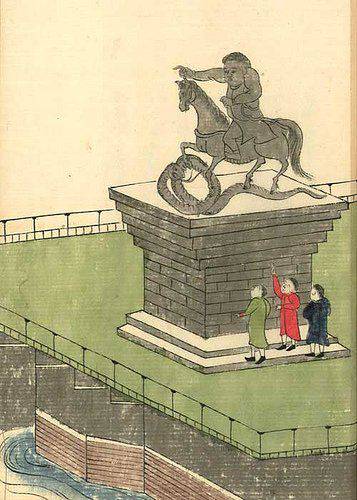
Monument to Peter the Great in Petersburg. So he saw Koda. Tokyo National Museum.
He was surprised that people take water directly from the river, and the wells dig only in the villages. I noticed that the Russians love to boast of their wealth, but that he saw few in Russia, and many of them were prison inmates. It was extremely surprising to Koda that after the bath the Russians were in heels. But when he also put on a yukata (light robe) after the bath, it caused a real sensation, and many began to follow his example and brought themselves similar bathrobes.
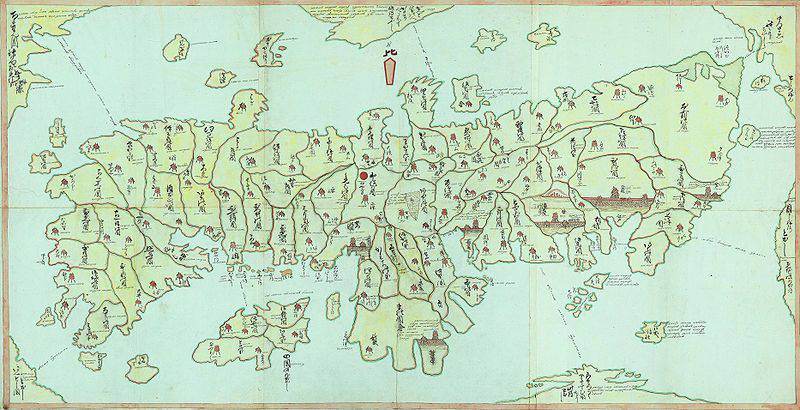
Map of Japan, drawn Koda.
Russia surprised him with the lack of palanquins. And not so much the palanquins themselves, the Russians for some reason did not want to believe his stories about them: “It cannot be that people force other people to carry themselves, it's sinful!” The Japanese were surprised that in Russia they pray images of God (icons) and wear his figure (cross) on his chest. The fact is that by this time Christianity, which had spread in Japan through the efforts of the Jesuits, had long been expelled from it, and to confess something other than Buddhism was again strictly strictly forbidden!
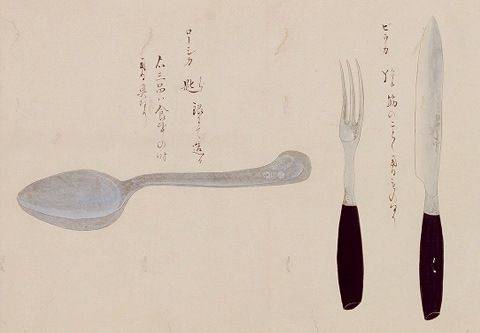
Spoon, fork and knife are truly amazing things for the Japanese of that time. Tokyo National Museum.
But the most amazing thing is that, having traveled all of Russia, and he was driving for a year, Kodau in his notes about Russia did not mention in a single word about the famous Russian drunkenness, which was always present in the descriptions of travelers from the West. That is, judging by what he wrote, it did not exist in nature, and this suggests, and where then drank more? He also visited many green places of St. Petersburg and spoke in detail about brothels, which he liked very much, quite legally existed and were very popular among Russian people of very different wealth and rank. It is surprising that inside these institutions were richly removed, and the courtesy of the girls, who not only did not take money from him, but on the contrary, gave him gifts themselves, exceeded all his expectations.
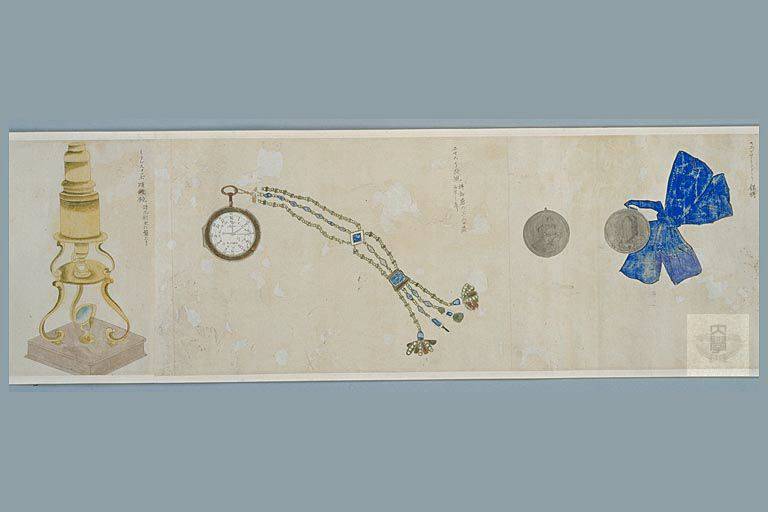
Microscope, watches and medals - all this Koda painted very carefully! Tokyo National Museum.
But what struck him most in our country was the ... latrines. In Japan, they were placed on four pillars, elevating above the ground, the pits below were not dug, and the feces falling down were immediately collected and ... having collected enough, they were sold as fertilizers. After all, the peasants did not have cattle, they had nothing to feed him. The Japanese did not know the taste of cow's milk. Only samurai had horses. And what was to fertilize their fields? And then there is such “wealth”, and in the winter it just freezes like that, and in the summer it disappears without benefit! Although he noted that thanks to this, there are no problems in Russia with the extraction of nitrate (it was then obtained from the land that was dug near by “visits”!), Therefore the powder in Russia was excellent! One more circumstance, so to speak, of "intimate quality", Koda also did not understand. Rather, he was very surprised that if you listen to Russian men, they all now and then talk about ... "dzappa ebëto." But if they only offer this very thing (and among samurai, and even simple Japanese, including sailors and merchants, male-to-male sexual contacts were considered quite normal!), As they were embarrassed, and even refused to be angry! That is, to do it badly, but to speak, it means good? “Then why talk about it if you don’t do it?” Wondered Koda.
He did not understand the Russian system of finance and credit. The very concept of "bank" remained for him nothing more than a beautiful building. But what exactly they did there, he failed to understand himself.
In the end, he received the same permission to return to Japan. From the empress at parting, he received a snuff box, a gold medal, and 150 gold chervonets and, not clear why, why, a microscope.
Well, the government was quick to use this situation to establish diplomatic and trade relations with Japan. So 20 May 1792, three Japanese boarded the brigantine "Catherine" and, together with the first Russian embassy, sailed to its shores. The visit was given a semi-official character, so that in case something happens, “do not suffer any damage”.
October 9 1792, the embassy arrived in Japan, but it was restricted to move, and although the Japanese sailed, they did not execute, they were sent to different places, and then they began to interrogate everything that happened to them in Russia. The court physician of the Shogun Katsuragawa Khosya, according to Kodau, wrote a voluminous work “Hokusa Bonryaku” (“Brief news about wandering in the Northern waters”), consisting of eleven sections. However, it was immediately classified and stored in the imperial archive without access rights until 1937, when it was published in very small editions.
Interestingly, Captain Kodayu also compiled the first Russian-Japanese dictionary, which contained a whole section of profanity in the Russian vocabulary of the time, which, however, seemed to him quite usable!

Travel map Koda "back and forth."
Well, the Russian embassy was in Japan until the end of July 1793, and even managed to get permission for one Russian ship per year that could arrive at the port of Nagasaki. But the Russian government did not take advantage of them, and after Catherine's death, Japan was completely forgotten, since she was very far away! Now we can only guess how the course of history would change if Russia and Japan could establish diplomatic and trade relations between themselves at that time. Perhaps the whole subsequent history of mankind would have changed, and the world would be completely different today? On the other hand, in order for contacts between our states to be maintained and developed, mutual interest was required. But it practically was not there! Well, what could the Russian Empire offer the Japanese from such a territory as the Far East? Traditional Russian furs, gunpowder, weapon? They didn’t need furs, because that was their culture, and the Japanese didn’t need gunpowder and weapons during the Edo era because peace reigned in the country, and militant foreigners had not reached it yet. But there are no common points of contact, there is no mutual interest, there are no contacts at the political, cultural and all other levels, without which the strong ties of the two countries are impossible!
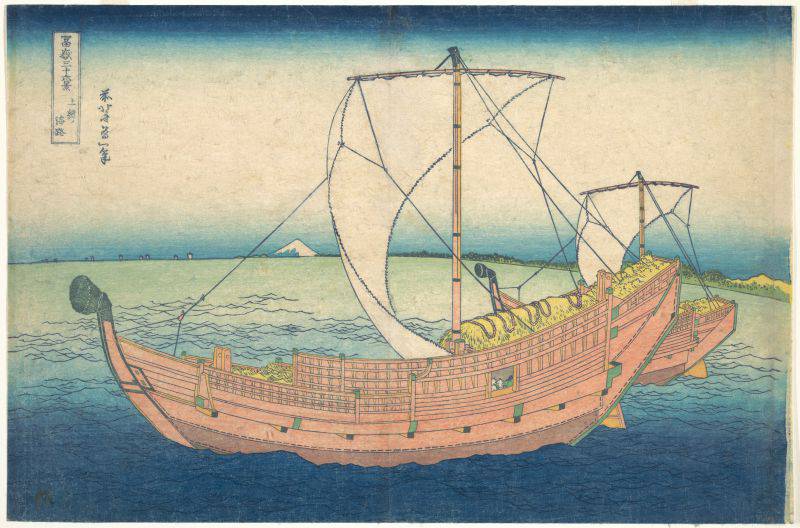
Information